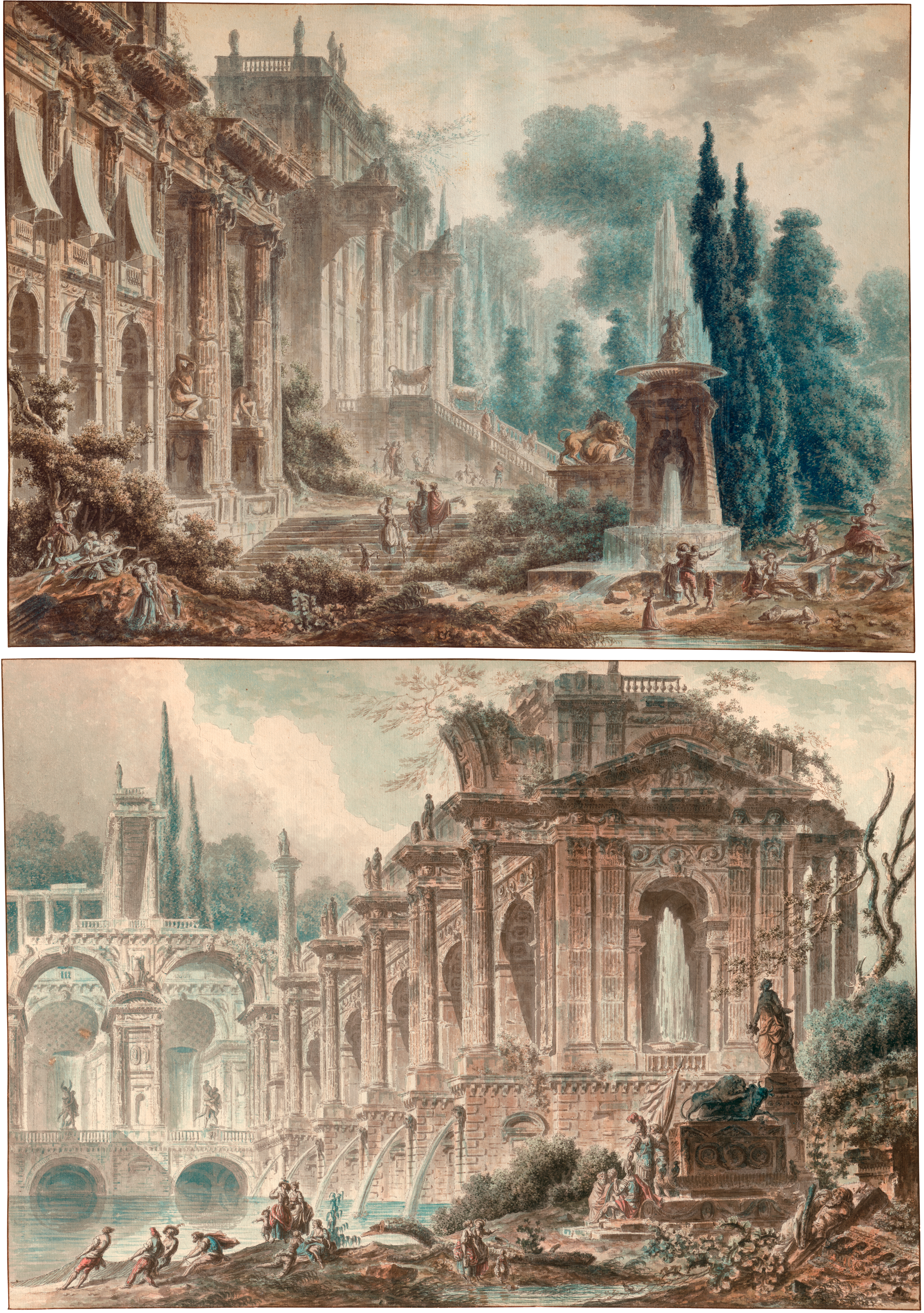Loading the page ...
Jacques-Henry-Alexandre Pernet
(circa 1763 Paris)
Two Capriccios of Ruins. Each in pen and black ink and watercolour, framing line in pen and brown ink. Each approx. 42 x 58.5 cm.
Little is known about the life and work of Jacques-Henry-Alexandre Pernet, a vedutist and painter of ruins, which may seem strange given the excellent artistic quality of the two watercolours presented here. Born the son of a perfumer in Paris around 1763, Pernet studied under the architectural painter, Pierre Antoine de Machy (1723–1807) and was listed among the pupils of the Académie royale de peinture et de sculpture in 1783. The only documentary evidence of his artistic activity, apart from his participation in the Salon de la Correspondance in Paris, is the existence of a few works dating to between 1784 and 1789.
The artist was undoubtedly inspired by Hubert Robert’s paintings of ruins. Characteristic of Pernet’s oeuvre are capriccios with ancient ruins, banisters, triumphal arches, colonnades and statues situated in lush, park-like landscapes and rendered in a greatly foreshortened perspective. The soft colouring, which is reduced to a few blue-green and brown tones, is both typical of the period and reminiscent of contemporaries such as Hubert Robert and Louis Jean Desprez. Giovanni Battista Piranesi’s corpus of prints and drawings had a decisive influence on a whole generation of young French artists – the Piranésiens, as they were called – and they also proved inspirational for Pernet. This generation included artists such as Charles Michel-Ange Challe, Louis Jean Desprez, Jean-Laurent Legeay, Louis-Joseph Le Lorrain, Ennemond-Alexandre Petitot and Charles de Wailly, to name but a few (see exhibition catalogue Piranèse et les Français 1740–1790, Académie de France à Rome, 1976).
The two watercolours on offer here, both confidently executed in great detail, are distinguished by their refined and elaborate pictorial composition and the abundance of delightful ideas and anecdotal details – a feature that also brings Pernet’s brilliant contemporary Desprez to mind. A stylistically very similar watercolour by Pernet of roughly the same size is in the collection of the Royal Institute of British Architects in London (see Piranèse et les Français 1740–1790, Rome 1976, fig. 130).The dramatic perspective foreshortening of the imposing ancient buildings produces a spectacular spatial effect. Individual architectural elements such as columns, crown mouldings and the ornamentation of the splendid, partly ruinous architecture are rendered with loving attention to detail. Visible against this imposing backdrop is a merry fête galante. Lovers embrace and tease each other, play music or stroll in the spacious pleasure garden. The rushing of the fountains is all but audible while the eye delights in humorous occurrences such as that in the right foreground, where an elegantly dressed lady tumbles off a seesaw. On the companion piece, which is dominated by magnificent triumphal architecture, fishermen can be seen hauling in their nets. A group of warriors in ancient attire have gathered in front of a sarcophagus, while in the right foreground a nymph with a club over her shoulder nestles against a satyr’s herm, arousing phallic associations and lending the scene a a voluptuous, erotic note. Pernet gives expression here to the gallant attitude to life of the Ancien Régime in a highly memorable and original manner.
Contact us for further information